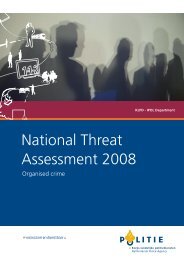Assessing the Effectiveness of Organized Crime Control Strategies ...
Assessing the Effectiveness of Organized Crime Control Strategies ...
Assessing the Effectiveness of Organized Crime Control Strategies ...
Create successful ePaper yourself
Turn your PDF publications into a flip-book with our unique Google optimized e-Paper software.
Albanese (1996:181) adds:<br />
The adjustment problems <strong>of</strong> undercover <strong>of</strong>ficers after completing <strong>the</strong>ir assignment<br />
has also not received enough attention from ei<strong>the</strong>r police agencies or <strong>the</strong> public. The<br />
FBI claims that its undercover agents were responsible for 680 convictions, $5.7<br />
million in forfeitures, and $741.1 million in potential economic losses prevented in a<br />
single year. Although <strong>the</strong>se figures were modified somewhat by a General<br />
Accounting Office audit, <strong>the</strong> benefits <strong>of</strong> undercover work have not yet been<br />
objectively evaluated against <strong>the</strong>ir costs in terms <strong>of</strong> time invested, risk, manpower,<br />
and <strong>the</strong>ir impact on <strong>the</strong> <strong>of</strong>ficer, <strong>the</strong> police agency, and on affected third parties.<br />
Albanese points out that agent Joe Pistone and his family had to relocate four times while he was<br />
testifying, that he did not see his family for three months while undercover, and that he resigned<br />
from <strong>the</strong> FBI prior to earning a pension because <strong>of</strong> threats against him. Pistone believes <strong>the</strong>re is<br />
a large contract out on his life and he feels hunted by those he once investigated.<br />
Marx (1988:113) lists <strong>the</strong> outcomes for a number <strong>of</strong> police sting operations set up to ensnare<br />
those involved in property crimes. While <strong>the</strong> tally <strong>of</strong> arrests and convictions seem impressive,<br />
<strong>the</strong>se studies provide little comparison with o<strong>the</strong>r investigative methods and provide little<br />
information on <strong>the</strong> overall impact <strong>of</strong> <strong>the</strong>se operations on crime in <strong>the</strong> relevant jurisdictions.<br />
Where such information was available, no impact on crime was observed. In any event, this<br />
evaluation did not pertain to undercover work in relation to large-scale criminal enterprises.<br />
Ultimately, <strong>the</strong> value <strong>of</strong> information obtained through various undercover operations may defy<br />
quantification. Kenney and Finckenauer (1995:332) note that, “<strong>the</strong>re is no obvious way to<br />
measure <strong>the</strong> worth <strong>of</strong> an informant’s information against <strong>the</strong> costs <strong>of</strong> that information and <strong>the</strong><br />
risks <strong>of</strong> unreliability and lack <strong>of</strong> credibility. This remains an exercise <strong>of</strong> pr<strong>of</strong>essional judgment<br />
and discretion.”<br />
4.14 Electronic Surveillance<br />
Electronic surveillance includes a number <strong>of</strong> techniques, varying in <strong>the</strong> extent to which <strong>the</strong>y<br />
invade <strong>the</strong> privacy <strong>of</strong> <strong>the</strong> target. Some techniques are non-consensual, as none <strong>of</strong> <strong>the</strong> parties are<br />
aware that <strong>the</strong>y are being monitored. O<strong>the</strong>r techniques adopt one-party consensual monitoring,<br />
such as those in which undercover agents use a concealed tape recorder to record conversations<br />
or where one party to a telephone conversation consents to <strong>the</strong> recording <strong>of</strong> that conversation<br />
unbeknownst to <strong>the</strong> o<strong>the</strong>r party (Kenney and Finckenauer, 1995:337). Apart from tape recording<br />
and intercepting communications over a telephone line (or wiretapping), electronic surveillance<br />
may involve video recordings, eavesdropping through <strong>the</strong> use <strong>of</strong> hidden microphones (bugging),<br />
and more advanced laser and fiber optics technologies (Abadinsky, 2003:344).<br />
Many law enforcement <strong>of</strong>ficials believe that <strong>the</strong> use <strong>of</strong> electronic surveillance is indispensable in<br />
<strong>the</strong> fight against OC because o<strong>the</strong>r sources <strong>of</strong> evidence are <strong>of</strong>ten unreliable or unavailable.<br />
Witnesses are <strong>of</strong>ten afraid to come forward, informants may be unreliable, and many criminal<br />
organizations are difficult to infiltrate. Fur<strong>the</strong>rmore, as <strong>the</strong> business <strong>of</strong> OC is usually conducted<br />
Research and Statistics Division / Department <strong>of</strong> Justice Canada | 45








